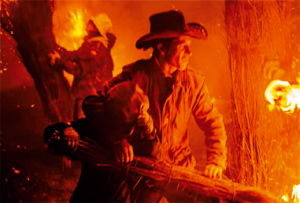Festival of the Escobazos

The Festival of the Escobazos is a show that takes place on December 7 of each year in the town of Jarandilla, Cáceres and where thousands of brooms are illuminated to pay tribute to the Virgin Immaculate Conception, a tradition of many years and that still remains valid.
What is the festival about?
This traditional festival, which has been taking place since ancient times, has its usual appointment in the Plaza Mayor de Jarandilla, province of Cáceres, Spain. In this emblematic place, they meet every December 7 and at dawn on December 8 the locals of the area, who, carrying in their hands large brooms made of "retama", proceed to light them and then greet those present at the point of brooms.
The event lasts approximately three hours. Then, the procession of the Banner of the Virgin of the Immaculate Conception begins, which is carried by a horseman and also accompanied by the attendees, who carry the brooms lit, which act as torches, making this moment a true religious experience.
After the procession, the burning of the bonfires begins, which is an ideal moment for the families of the place, neighbors and visitors to take advantage of the opportunity to taste the delicious pitarra wine, which is harvested in this region of Spain, as well like the most varied sweets, which are a true delight to the palate and are given during this celebration, all this, while singing hymns and popular verses to the Virgin.
Origin of this festivity
According to historical data, the origin of this festival began when the inhabitants of Jarandilla decided to proclaim the festival long before Rome did, thanks to the intervention of Pope Pius IX, who in 1854 declared the Virgin, immaculate.
Over the years and to carry out the celebration of the Virgin of the Conception, which casually coincided with the end of the harvest in Autumn, the shepherds, goatherds and inhabitants of Jarandilla de la Vera attended this event descending the Sierra at night hours and thus be able to arrive on time to meet the Virgin.
However, at that time they did not have enough light and to avoid setbacks and accidents during the tour, they decided to use brooms made of "retama", which is a typical bush of this area, with which they made torches and thus be able to illuminate the path during the night.

The other popular belief is that the shepherds and inhabitants of the mountains, once their shepherding days were over, they used to greet each other by exchanging brooms as a way of greeting each other and thus showing joy after spending long periods without seeing each other.
From there, the tradition was born, which over the years has been transformed into an event that brings together both neighbors and visitors from nearby towns to make this party a meeting full of cordiality, joy and merriment that without a doubt it will be very difficult to forget.
Some curiosities about this traditional festival
This peculiar tradition also presents some curious facts, which are described below:
- The procession of the Inmaculate Conception was also called the procession of the donkeys because their owners believed that in this way they could be cured of some disease.
- This festival was already an old tradition in Spain, long before Pope Pius IX proclaimed it on December 8th, 1854.
- During the procession of the Virgin, two banners are displayed, one on Decembre 07th and other on December 08th.
Tips and rules that visitors must follow
One of the main tips that people must comply with is to avoid agglomerations that cause accidents, it is also necessary to use old clothing that is not flammable, preferably jeans, cloths, etc. In addition, it is also advisable to cover some parts of the body such as neck, head and hands to avoid possible burns.

On the other hand, participants to the event should not be hit in the upper body areas with the broom on and when the banner is lowered, brooms should not be used. It is forbidden inside the church to drink liquor and much less smoke.
What other things to see or do in the town if you go to the party?
Jarandilla de la Vera is a beautiful town located in Cáceres and which you will be captivated if you go to the "Fiesta de los Escobazos". It is one of the places that receives the largest number of tourists in all of Extremadura for its charm. Here we tell you what you can do and what places are mandatory places to visit.
Surrounded by mysterious places such as the circular footprints found in 1997 that still have no explanation and that will surprise you when you visit the facilities of the "La Berrocosa" farm.
You can also visit the churches and hermitages in the area such as the "Cristo" or "Nuestra Señora de la Torre". If you want to look for an inn, you will love spending a night at the famous "Castillo Parador de Jarandilla", a true oasis of tranquility.
Other fascinating places are the "Garganta de Guatalmino" and its famous Devil's Waterfall, which is undoubtedly a wonderful spectacle. Also recommended are the "Sierra de Gredos" and "Tormantos".
What to eat in Jarandilla de la Vera?
If it is about gastronomy, you cannot stop tasting the delicious dishes of Extremadura cuisine, among which the revolconas potatoes, made with bacon and a paprika puree, its exquisite Extremadura crumbs, made with fried breadcrumbs or the delicious braised goatling. It also has a great variety of sweets and desserts such as milk, anise and cinnamon repápalos or the famous hot strawberries from the forest with an appetizing meringue ice cream.






